Thousands of people lost their lives and thousands more were injured in a 7.8-magnitude earthquake that hit Nepal’s capital Kathmandu and its surrounding areas on 25 April.
The earthquake was followed by a large number of aftershocks, including one that measured 7.3 on 12 May.
Animated map: The earthquake and its 120 aftershocks
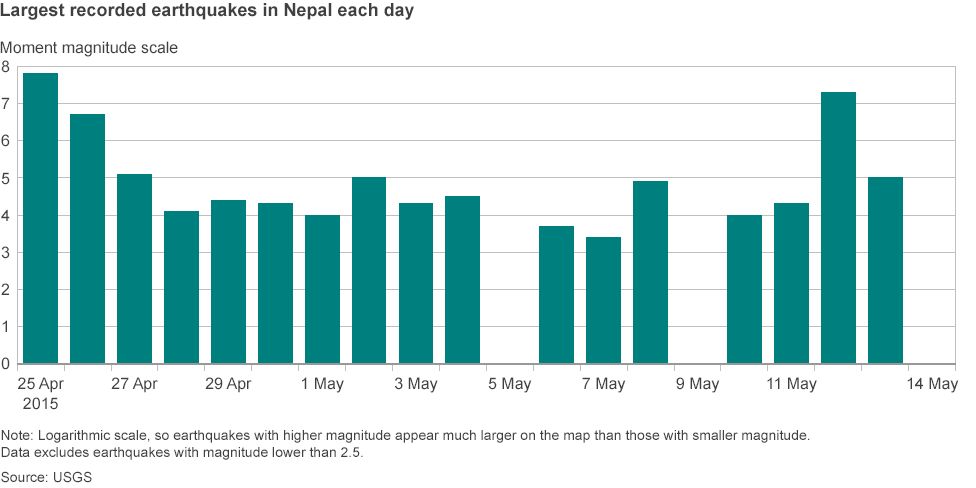
Among the worst-hit districts was Sindhupalchok – where more than 2,000 died. In the capital, Kathmandu, more than 1,000 perished. Thousands more were badly injured by falling debris caused by the quake or powerful aftershocks that rocked the region. Mount Everest was also struck by deadly avalanches after the quake on 25 April.
Worst-affected areas
Since then, people are living in makeshift camps around Kathmandu, having been made homeless by the quake or because they are too afraid to stay inside. Some have tried to leave the capital amid fears of further aftershocks.
Many of the country’s historic sites have been severely damaged, including temples and monuments.
Kathmandu
Analysis of satellite imagery captured before and after the devastating quake reveals that more than 180 buildings in the densely populated city centre were destroyed.
At least four out of seven Unesco World Heritage sites in the Kathmandu valley – three of them ancient city squares – were badly affected.
Building damage in Kathmandu: 27 April 2015

Dharahara tower, Kathmandu: 27 October 1998 and 26 April 2015
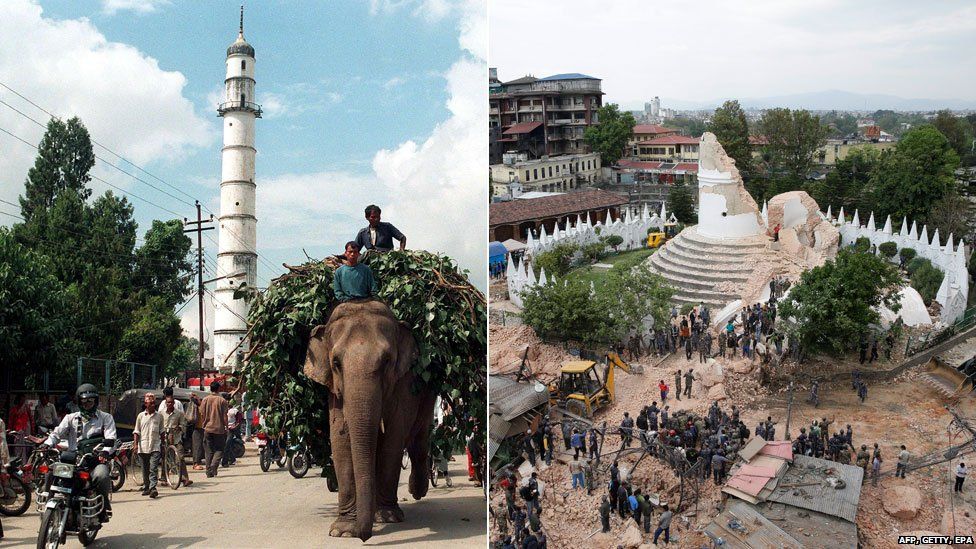
Image copyrightAFP, GETTY, EPA
The capital’s Durbar Square – the royal Nepalese residence until the 19th century – has also suffered, with many buildings reduced to rubble.
Durbar Square, Kathmandu: via satellite before and after the quake

Durbar Square, Kathmandu: February 2015

Durbar Square, Kathmandu: 27 April 2015

Temporary shelters have been set up on open spaces in the city – such as fields and stadiums. They offer some protection to families who have lost their homes or those too scared to stay inside after the quake and powerful aftershocks.
‘Tent city’: field in Kathmandu via satellite before and after the quake

Narayanhiti Palace, Kathmandu: via satellite before and after the quake


Bhaktapur
In Bhaktapur, which had been the country’s best preserved old city, initial reports claim half of all buildings have been destroyed and 80% of temples damaged.
The ancient city, one of the worst-affected areas, lies to the east of the capital.
Durbar Square, Bhaktapur: February 2015

Durbar Square, Bhaktapur: April 2015
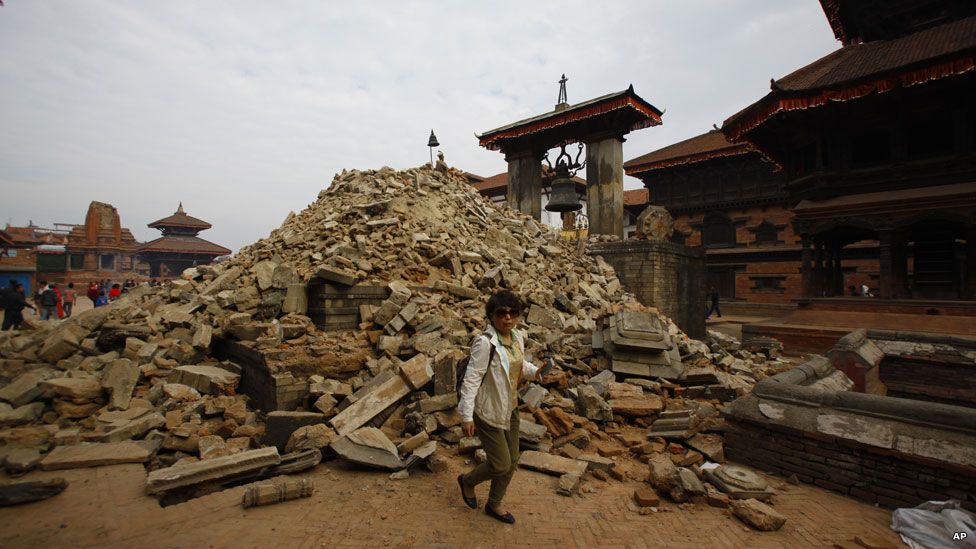

Search and rescue operation
International teams of rescuers and medical experts are arriving in Nepal to help hunt and care for earthquake survivors.
-
How a search and rescue operation is carried out

-
Strong buildings

Rescue workers need to be swift to assess where they are most likely to find survivors inside collapsed buildings. Stairwells or the spaces under large concrete beams can provide what rescue workers call ‘voids’, in which people may have survived.
-
Video cameras
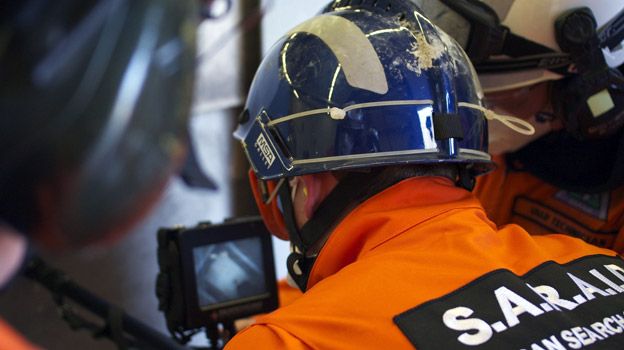
Video cameras placed on the end of flexible poles can be squeezed through gaps in the rubble to help locate survivors. Using this technique means time is saved as less rubble is shifted unnecessarily. Thermal imaging equipment can also be used to locate survivors as their body heat can warm the rubble around them
-
Listening for survivors

Specialist sound equipment can detect the faintest of noises to within a few metres. Silence on the site is needed while a member of the rescue team bangs three times and hopes to hear a response. Carbon dioxide detectors can be used to find survivors rendered unconscious. They work best in confined spaces where they detect the greater CO2 concentration in the air exhaled by those still breathing.
-
Weak buildings
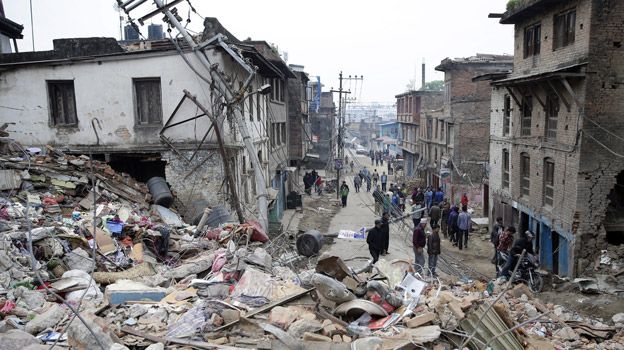
Many of the buildings in Nepal collapsed in the initial earthquake or the aftershock. Many older neighbourhoods in the capital, Kathmandu, were made up of poorly-constructed brick buildings and these were largely destroyed in the disaster. Fewer, modern structures collapsed.
-
Local knowledge

Local people often know the best locations to begin the search for survivors. After speaking to them rescue workers can quickly select the most promising place to begin their work. Many local people have also joined in the search for survivors.
-
Search and rescue

The co-ordinating agency, usually the UN, and the host country, have to take the difficult decision of when to stop looking for a few remaining trapped people and concentrate resources on looking after the thousands of other survivors. The average time for this switch is between five and seven days, but individuals have been known to survive as long as 13 days, if they have access to water.
-
Rescue dogs

Dogs are extremely effective at using their sense of smell to pick up on signs of life that human rescuers cannot. They are also able to cover large areas quickly, speeding up the search and rescue process.
-
Lifting equipment

Diggers and hydraulic jacks are among the heavy machinery that rescue workers employ to shift rubble. Large concrete slabs on the outside of buildings can be pulled aside by diggers, enabling rescuers to get a view of any people still trapped inside. Rescue workers are also taking chainsaws and other power tools to cut through wreckage.
-
Shifting rubble

Before the heavy-lifting equipment arrives, rescuers use pick axes and shovels to dig through the rubble. Other tools used by rescuers include chainsaws, disc-cutters and rebar cutters – which can be used to tackle the metal bars in reinforced concrete.
The United Nations, which estimates 6.6 million people live in the districts affected by the earthquake, is helping to co-ordinate rescue efforts.
Many have been left homeless by the disaster and the country is already reported to be running out of water and food. There are also frequent power cuts.
The British organisation, Search and Rescue Assistance in Disasters (SARAID) has sent a team of experts with 1.5 tonnes of specialist equipment. This includes an electrical power generator and power tools for cutting through concrete and steel.
They also have their own tents and food supplies, so they will not be a drain on local resources.
India and China are among the other countries to send teams of rescuers.
Sourced from BBC News







